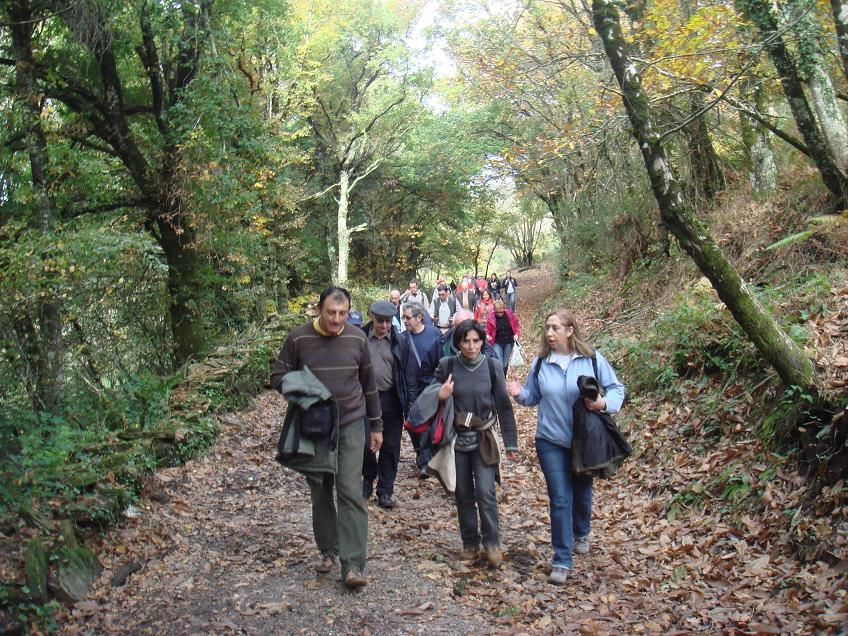 |
| Facendo camiño polas carballeiras de Serés |
Visita á igrexa e ao convento con explicacións de Pedro Paulo. Desde aquí reivindicamos que este lugar emblemático se protexa e rehabilite. De San Cibrao subimos camiño do lugar do Barreiro para visitar a capela de Santa Petronila e, desde aquí, ao cruceiro de Cugula, cruceiro que reivindicamos que se protexa e que se retiren do seu carón elementos espúreos. Desde o cruceiro fomos por un vello camiño de carros, chamado camiño de Rivel. Ao pasarmos por este lugar puidemos observar que na chousa da marxe dereita había un xabarín que, moito nos tememos, é para adestramento dos cans de caza, práctica esta prohibida pola lei: non se pode pechar un animal e logo azuzarlle media ducia ou unha ducia de cans; cousa que parece máis doutras épocas ca de xente civilizada do século XXI. Reivindicamos desde aquí que se tomen as medidas oportunas para erradicar estas prácticas.
Xa na parroquia de Pena visita ao hórreo do barrio de Piñeiro, único hórreo que queda na parroquia: parabéns á familia que o segue a manter en pé. Seguidamente, polo camiño da Grova baixamos en dirección ao rochedo da pena e igrexa, onde puidemos observar unha fermosa vista sobre a parroquia e o rochedo, onde en tempos houbo un asentamento dunha fortaleza e desde onde se dominaba o couto de Pena. Pola corredoira da Bica da Fonte chegamos ao pé da fonte de Amoreira, levantada en 1931, e sendo obxecto de reformas desafortunadas recentemente. Xa ao pé da pena puidemos contemplar o impoñente rochedo e a igrexa, onde Ricardo Polín explicou o sentido dos enterramentos nos adros das igrexas e a construcción de nichos, cun estilo semellante ao da fonte de Amoreira. Logo fíxose referencia ao enterramento de dous guerrilleiros anónimos, fóra do que era o campo santo. Aproveitando o momento para unha nova reivindicación: a necesidade de poñer unha placa que lembre as estes loitadores. Na fachada da igrexa débense salientar dúas simboloxías góticas que se encontran no leteral sureste. Así coma a alusión á casa reitoral levantada polo pobo, mais propiedade da igrexa e que, coma ocorre con outras casas reitoriais, non se pode facer nada porque son propiedade da igrexa, aínda que levantadas co esforzo dos veciños. Desde Pena a Carballedo, mais saíndo xa de Pena, fíxose unha nova alusión, neste a unha das fontes do río Chamoso, no lugar de Pioute ou Picoute, onde abriron unha canteira e enterraron a cova. Cova dos mouros e fonte (de onde brotaba a auga), que recentemente voltaron intentar continuar coa explotación da canteira. Mais os veciños foron capaces de que non seguira adiante esta explotación. O lugar e o seus camiños, con vistas sobre os soutos e carballeiras que nos levan ao pazo de Carballedo son unha zona BIC, obxecto de especial protección como o pode ser Soutomerille, no Plan Xeral de Ordenación Municipal. Logo de cruzarmos un dos nacementos do río Chamoso chegamos a Carballedo, onde o seu impresionante pazo, levantado polos anos 1660, con dúas alturas, dependendo desde onde se mire, posúe dous fermosos escudos, podéndose apreciar nun deles representada a Cruz de Santiago. Este pazo é un dos máis representativos da cultura pacega de Castroverde. Mágoa que non haxa institución ou particular que se faga cargo deste edificio e das súas pertenzas, respectando sempre o seu enclave e contorna. Desde este lugar pódese ver toda a serra do Miradoiro, o monte de Toldaos e a Croa de Bolaño. Salientar á parte do pazo, o forno e o lavadoiro. Comentar que, se subiramos desde o lugar de Pozos, poderiamos ter outra vista do pazo, ao tempo que pisariamos o vello camiño dos arrieiros, que comunicaba Mondoñedo e Meira coa saída camiño a Castela. Desde Carballedo a Serés, rematando por hoxe o percorrido e agardando poder continuar para o próximo roteiro, día 10 de decembro, no que iriamos de Serés a Barredo. Moitas grazas a todos os participantes, entrevistados e informantes.
Saúde, Terra e Lingua.
Manolo Muñiz
BRIEF SUMMARY OF THE ROTEIRO SAINT CIBRAO-PENA and SERÉS
Around 10:00 h. we started with the recordings Luisa and Chema of TIC Foundation made, whom we have to thank for the interview and beginning of the tour (“roteiro”). They began by interviewing me about the birth of the Asociation and specifically about this itinerary. Then, Pedro Paulo told us about Saint Cibrao’s history, about the church, convent and also the “historical memory” (what we call memoria histórica). Also interviewed were Amanda of Ohio, that spoke about these lands and Galicia, and lastly spoke Antonio, manager of the Asoc. Terras de Lugo, on the vision of Castroverde as member of the region of the lands of Lugo.
We visited the church and the convent with explanations of Pedro Paulo. In this text we wish to claim protection for this emblematic place. From Saint Cibrao we went to the place of Barreiro to visit the chapel of Santa Petronila and, from here, to the crossroad and stone cross of Cugula, a place we understand deserves better protection, free of alien elements. Afterwards we walked along a way of carts (“carros”) called way of Rivel, going through which we noticed that on a right-hand side“chousa” (estate, grounds) there was a wild boar used for training hunting dogs, a practice forbidden by the law: It should always be banned to cage an animal and then set half a dozen or a dozen dogs on it. This belongs more in past times than it does in nowadays’.
Already in the parish (“parroquia”) of Pena, we stop by the “hórreo” (a kind of warehouse) of the Piñeiro neightbourhood, the only one that remains in the parish: congratulations to the family that keeps it up. Next, by the way of the Grova, we went down in direction to the crag and the church, where we could have a beautiful view on the parish and the “rochedo” (rock or crag) where in time a fortress was settled and from where the possessions of Pena were dominated. From the Bica da Fonte path, we arrive at the foot of Amoreira’s fountain, built in 1931, being object of recent and unfortunate reforms. Once at the foot of the rock we could behold the spectacular “rochedo” and the church where Ricardo Polín explained to us the sense of the burials peformed in the church’s fenced grounds, and the construction of niches (tombs). Then he made a reference to the burial of two anonymous warriors (“guerilleiros”) out of the saint field. A banner remembering this two heros is nothing more than they deserve. In the façade of the church we should point out the two Gothic groups of symbols placed in the southeastern lateral. He then mentioned the “rectorial” (belonging to the priest of the town or village) house raised by the people of the village, but property of the church and thus not subject of reform or improvement, as it happens with other “rectorial” houses. Why? Just because they are property of the church, although raised with the effort of the neighbours. Going from Pena to Carballedo, other allusion was made to one of the sources of the river Chamoso, in the place of Pioute, where a quarry was opened and the cave buried. The Moors cave and water source where the river sprang, were recently menaced again as they tried to continue with the exploitation of the quarry, yet the neighbours were able to prevent it.This place and its paths with a view of the groves and “carballeiras” (oaktrees forest) that take us to the “Pazo” (big house) of Carballedo are considered a BIC (Bien de Interés Cultural, protected at Spanish state level), place subject of special protection, as Soutomerille can be, also included in the General Plan of Local Organisation. After crossing one of the river Chamoso sources, we arrived at Carballedo, where we visited its incredible “pazo”, put up circa 1660, having two coats of arms one of which has the Santiago Cross carved in. This “pazo” is one of the most representative examples of this Castroverde architectural traditon. It’s a pity that there is not a institution (public or private) or individual in charge of this building and its belongings, always respecting its enclave and surroundings. Its oven and washing place outdoors should also be pointed out. If we had gone up from the place of Pozos, we could have had another view of the “pazo”, and at the same time we would have step on the old path of the “arrieiros” (“arriero” or mule driver) that communicated Mondoñedo and Meira with the exit way to Castilla. From Carballedo to Serés, having finished today’s walk, and looking forward to continuing with the next tour (roteiro) on 10th December, that will go from Serés to Barredo. Thank you very much to all the participants and interviewed.
Manolo Muñiz










Deixa unha resposta